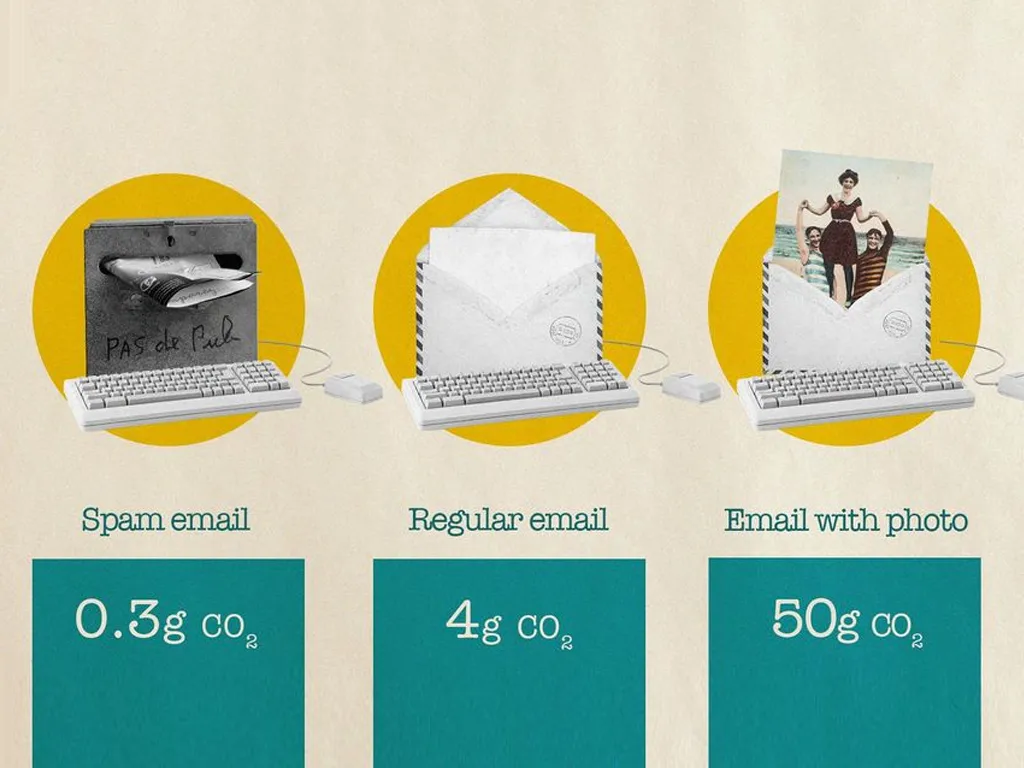Reduce Your Email Marketing Carbon Footprint

Although most existing research focuses on how individuals use email, it is easy to make the connection between marketing emails and their possible influence on the environment.
If you market via email, you frequently see email marketing performance metrics. Say the open rate for your campaigns is typically 30%. That is quite strong. In addition, this data indicates that 70% of the sent emails were not opened. There will also be a large number of subscribers who choose to ignore or maybe forget about those emails and not delete them.
Additionally, email marketing campaigns are time specific. After some time, the particular email campaign won’t be relevant. So, where does the issue lie? It is when the people who have those emails don’t delete them. Unopened/undeleted emails lead to the servers housing those emails using electricity to store them, which is wasteful.
Therefore, a straightforward email marketing campaign might generate significant carbon emissions if employed improperly. You won’t need to worry, though, since you will understand exactly how to lessen the carbon footprint of your email marketing campaign after reading this article. Let’s begin by explicitly understanding an email’s carbon footprint.
What is the carbon footprint of an email?
The technology used in email marketing continues to cause environmental harm and produce carbon footprint . Electricity is used to power the computer and the server running the cloud-based email provider whenever an email is sent. The issue is made worse because servers produce heat and thus must be cooled down.
An email can sit in a person’s inbox for days or months after being received, utilizing electricity in the data centers that support and back up the inboxes. Email content may become irrelevant as promotional offers and communications expire, but it still takes up server space. The electricity required to run most servers is produced from fossil fuels because they are operated as economically as possible and are not fuelled by green energy.
This use of electricity produced by fossil fuels is how a simple email can contribute towards carbon footprint generation. Now, let’s look at the amount of carbon an email can produce.
What is the production of carbon per email?
A few researchers have tried to determine how much carbon dioxide is produced by a single email. According to 2010 data from Mike Berners Lee’s book, How Bad Are Bananas?, the BBC claims that an average personal email has a carbon footprint of 4g CO2; however, a message with a large attachment may have a carbon impact of 50g CO2. According to Berners-Lee, a regular businessperson’s annual email output would generate enough energy to propel a vehicle 200 kilometers.

Source: https://www.bbc.com/future/article/20200305-why-your-internet-habits-are-not-as-clean-as-you-think
More than ten years have passed since the Berners-Lee study. It is frequently mentioned on the Internet by some sources that data centers(places where emails are stored) worldwide now use less energy. On the other hand, some contend that over the last decade, emails’ impact on the environment may have increased.
Of course, there are more environmental effects besides merely sending an email. As data centers support our overflowing inboxes, energy is consumed to store emails in the cloud. There are also numerous commercial and marketing emails from brands in there.
All the data about energy consumption might seem daunting for you as an email marketer. But you need not worry, as we have mentioned steps to help you reduce your carbon footprint without harming your marketing goals. Before that, let’s look at the primary causes of email’s carbon footprint.
What are the main reasons behind email’s carbon footprint?
Every day, millions of emails are sent, and each one emits carbon dioxide. Now, let’s focus on what aspects of emailing use the most energy; then, we will look at what can be done to lessen its negative environmental effects. Consider researching the average cost per kwh in Texas to understand the energy implications of digital communication practices.
The size of the email determines the carbon footprint generation-
When evaluating one email’s carbon footprint, the email’s size quickly comes to mind. You will need more electricity to power it through the Internet the more megabytes it has.
Recent research revealed that, as opposed to earlier predictions of 35 to 50 g for every 1 MB email, the actual amount of CO2e created by a 1 MB email is closer to 3.5 -4 g. However, it does not imply that we should cease caring. Even with all of these excessively huge emails you send, the size of your emails still impacts the creation of carbon footprints. Before sending an email, it is usually advisable to consider its size.
The spam section of the email-
One of the primary problems with email’s environmental impact is spam. After all, unwelcome emails irritate individuals in addition to using energy. Their transmission, reception, and even unintended storage all require energy.
Furthermore, there are many; just consider how much physical energy spammers squander worldwide.
Fortunately, spam filters identify and eventually delete unsolicited emails, preventing them from being in your inbox forever and reducing the CO2e emissions connected with them to about 0.3 g.
The servers and network used for the email
The servers contribute to the carbon footprint as well. There is little doubt that the environment is impacted by the energy used to run these services, including SMTP, DNS, and the several routers that emails must pass through. Email storage is another important factor to take into account. All of these demand significant energy.
Contrary to common belief, emailing does not consume most of the server energy. Consider that the world’s largest server providers, including Google, are focusing on guaranteeing that their data centers are carbon-free by supplying them with wind or solar energy. In that situation, it’s even one of the least harmful to the environment.
How to reduce the carbon footprint of your email marketing campaign
Now that we have seen the contribution of emails to carbon footprint, you might think about ditching email marketing altogether and concentrating on other marketing strategies like
But you don’t need to be worried anymore!
With these following tips, you can significantly reduce the carbon footprint generated by your email marketing campaign.
Here are some ideas to help you make your email marketing more environmentally friendly. We know that email is still vital in contemporary marketing and will always be!
Update your preferences and purge your email contact database.
Although unsubscribe buttons are not compulsory, how clear and simple are they to use? When was the last time you requested your audience to alter their preferences?
Consider asking your targeted audience to change their preferences and ask them to unsubscribe from emails that are not in sync with their needs and requirements.
This will decrease the number of pointless emails sent and received. This process in your marketing strategy will help you consistently connect with clients that benefit from the service/product you provide.
Additionally, be careful to routinely delete bounced email addresses. Low bounce rates indicate that your database is both clean and long-lasting.
To effectively target your messaging, segment your data.
Related to the previous point, you can, on your end itself, segment your client based on their specific requirements.
You need to build messages for each distinct set of clients by segmenting your database into several customer groups. Since targeted emails convey the appropriate message at the right time, the customers would be far more inclined to click on any links or visit your website.
Segmenting will make your email marketing campaign more successful and eco-friendly. Higher open rates, as a result, mean fewer emails that go unused. And on the plus side, Dotdigital claims that segmented and targeted email campaigns can enhance ROI by up to 760%.
Utilize an email pre-deployment tool to test your emails.
Have you ever been in a situation where you had to send a sorry email to your contact list after launching a campaign that had a cringe-worthy mistake or broken link? All of those additional emails need energy and produce carbon dioxide.
You can reduce this unwanted carbon footprint generation by thoroughly testing your emails before sending them. This mistake can easily be avoided with a little bit of carefulness on your end. All you need to do is edit and proofread your emails. You can do this by utilizing an email pre-deployment service like Email on Acid.
Avoid email blasts
Bulk campaigns that have not been targeted properly for your demographic are poor marketing practices, squander your time and resources, and adversely affect the environment.
To save time and resources, you can utilize a strategy where you may send fewer emails specifically to your well-targeted customers and prospects. Sending targeted emails will have less environmental impact.
Additionally, this will allow you to customize your emails. Customized emails will also help your customers and clients feel more valued and thus will have a more considerable impact.
Reduce the carbon bulge by reducing the file size of your email
Although GIFs are becoming increasingly popular, they consist of numerous images. Unfortunately, images and graphics will grow the file size even if they can improve the visual experience and draw attention.
Images and GIFs demand more energy to broadcast and receive emails and more storage space.
By eliminating GIFs, shrinking the size of your photos, and compressing them, you can improve loading speed, reduce email size, and provide a better user experience while using less energy.
Make sure your email does not land in the spam folder of your clients.
Your email landing in the spam folder of your clients is not a good thing! With this, your email is rendered useless and contributes to unnecessary energy consumption.
You can easily avoid this situation by
- Avoiding using caps and excessive exclamation for the subject of the email
- Not providing an unsubscribe link in the email
- Providing unnecessary attachments
- Attaching an excessive number of images, etc
These will likely land your email in the spam folder, so avoid these practices.
Conclusion-
In conclusion, we can all do more to increase the sustainability of our email marketing. These modifications reduce your carbon footprint while also being effective marketing practices. Additionally, they will improve the effectiveness and customer focus of your email marketing. Although these steps might seem minor and inconsequential, they all add up to rescue the earth.

